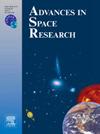ISWAT spacecraft surface charging review
IF 2.8
3区 地球科学
Q2 ASTRONOMY & ASTROPHYSICS
引用次数: 0
Abstract
The natural space environment exerts many harmful (called “space weather”) effects on spacecraft in orbit around the Earth as well as probes to other planets. The main hazards among these are surface charging, internal charging, single event effects, and total dose. Specifically, the ∼ keV electron population can have substantial impacts on spacecraft by causing spacecraft surface charging and electrostatic discharges (ESD). This hazard continues to be of great relevance today due to the continual evolution of the human use of space in terms of the number of satellites launched, the technologies they use and the design / manufacturing / test techniques used to build them. In the past, the majority of operating spacecraft were in Geosynchronous Earth Orbit (GEO), nowadays the Low-Earth orbit (LEO) satellite population dominates and the number of Non-Geostationary Satellite Orbit (NGSO) constellations increases; these new constellations are likely to increase the technical risks associated with harmful space weather conditions. This paper summarizes the state of art for surface charging including background of the phenomenon, data sources for characterizing charging on spacecraft, modeling of the space weather environment, surface charging modeling tools, and charging indices and metrics. Future directions and both near- and long-term recommendations are also provided.ISWAT 航天器表面充电审查
自然空间环境对环绕地球轨道的航天器以及对其他行星的探测器产生许多有害影响(称为 "空间天气")。其中主要的危害包括表面充电、内部充电、单次事件效应和总剂量。具体来说,∼ keV 电子群可通过造成航天器表面充电和静电放电(ESD)对航天器产生重大影响。由于人类对太空的利用在发射卫星的数量、所使用的技术以及建造这些卫星所使用的设计/制造/测试技术等方面都在不断发展,因此这种危害在今天仍然具有重大意义。过去,大多数运行中的航天器位于地球同步轨道(GEO),如今低地轨道(LEO)卫星数量占主导地位,非地球静止卫星轨道(NGSO)星座的数量也在增加;这些新星座可能会增加与有害空间天气条件相关的技术风险。本文总结了表面充电的技术现状,包括这一现象的背景、描述航天器充电特征的数据源、空间天气环境建模、表面充电建模工具以及充电指数和度量。此外,还提供了未来发展方向以及近期和长期建议。
本文章由计算机程序翻译,如有差异,请以英文原文为准。
求助全文
约1分钟内获得全文
求助全文
来源期刊

Advances in Space Research
地学天文-地球科学综合
CiteScore
5.20
自引率
11.50%
发文量
800
审稿时长
5.8 months
期刊介绍:
The COSPAR publication Advances in Space Research (ASR) is an open journal covering all areas of space research including: space studies of the Earth''s surface, meteorology, climate, the Earth-Moon system, planets and small bodies of the solar system, upper atmospheres, ionospheres and magnetospheres of the Earth and planets including reference atmospheres, space plasmas in the solar system, astrophysics from space, materials sciences in space, fundamental physics in space, space debris, space weather, Earth observations of space phenomena, etc.
NB: Please note that manuscripts related to life sciences as related to space are no more accepted for submission to Advances in Space Research. Such manuscripts should now be submitted to the new COSPAR Journal Life Sciences in Space Research (LSSR).
All submissions are reviewed by two scientists in the field. COSPAR is an interdisciplinary scientific organization concerned with the progress of space research on an international scale. Operating under the rules of ICSU, COSPAR ignores political considerations and considers all questions solely from the scientific viewpoint.
 求助内容:
求助内容: 应助结果提醒方式:
应助结果提醒方式:


